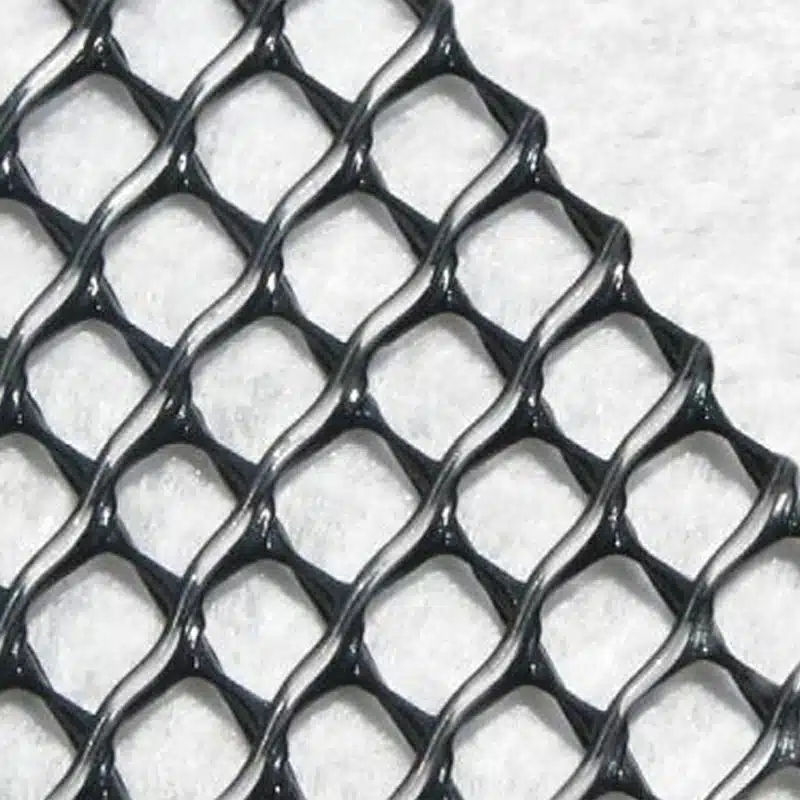+86-159 9860 6917
info@geofantex.com
geofantex@gmail.com
+86-400-8266163-44899
Geonets are grid-like materials designed for in-plane drainage capability. It is composed of a high-density polyethylene geonet drainage core heat fused to a non-woven filter fabric. They are used with a geotextile or geomembrane on either side to prevent soil intrusion and are typically made of PE resin.

What is a geonet made of?
All geonets that are currently available are made from polyethylene resin. The density varies from 0.94 to 0.96 mg/L, with the higher values forming the more rigid products. In this regard, the resin is true high-density polyethylene (HDPE) unlike the density used in HDPE geomembranes which is really medium density.
What is Geonet used for?
Geonets find application in various civil engineering and environmental projects due to their versatile nature. Here are some common uses:
- Drainage Systems: Geonets excel in facilitating efficient drainage in various applications, including landfill drainage systems, retaining walls, roadways, and athletic fields. Their open structure allows for the rapid flow of liquids, preventing water accumulation and potential damage caused by hydrostatic pressure.
- Soil Reinforcement: They contribute to soil stabilization and reinforcement in areas prone to erosion or landslides. Geonets act as stabilizing layers within soil structures, distributing loads evenly and enhancing overall stability.
- Environmental Protection: Geonets play a crucial role in environmental conservation by controlling soil erosion, managing sedimentation, and safeguarding landscapes from degradation due to water or other environmental factors.
- Construction Projects: They are used in various construction applications to improve drainage, enhance soil stability, and mitigate potential issues related to water accumulation or soil movement.
What is the difference between geogrid and geonet?
While both geogrids and geonets fall under the category of geosynthetic materials used in civil engineering, they serve different purposes due to their distinct structures and functionalities.
- Geogrid: Geogrids are grid-like structures typically made from polymers or other materials. They are used primarily for soil reinforcement and stabilization. Geogrids provide strength by distributing loads over a wider area, making them suitable for applications such as retaining walls, pavement reinforcement, and slope stabilization.
- Geonet: Geonets, on the other hand, are open mesh-like materials designed to facilitate efficient drainage. Their primary function is to allow the flow of liquids within soil or other materials while preventing water accumulation. Geonets are commonly employed in drainage systems, landfill applications, and erosion control due to their drainage capabilities.
What are the advantages of Geonet?
Drainage Efficiency: Geonets facilitate efficient drainage by allowing the easy flow of liquids within soil or other materials. Their open, grid-like structure promotes rapid drainage, preventing water accumulation and potential damage caused by hydrostatic pressure.
- Soil Reinforcement: They contribute to soil stabilization and reinforcement, especially in areas prone to erosion or landslides. Geonets act as a stabilizing layer, distributing loads evenly and enhancing the structural integrity of the soil.
- Versatility: Geonets are versatile and adaptable to various environmental conditions and construction needs. They can be customized to suit different project requirements, making them suitable for diverse applications.
- Environmental Protection: These materials aid in environmental conservation by preventing soil erosion, controlling sedimentation, and protecting landscapes from degradation due to water or other environmental factors.
- Longevity and Durability: Geonets are designed to withstand harsh conditions, offering durability and long-term performance. They resist chemical and biological degradation, ensuring their effectiveness over extended periods.
- Ease of Installation: They are relatively easy to install, reducing labor time and costs associated with implementation. Their installation methods are often straightforward, contributing to overall project efficiency.
- Cost-Effectiveness: Geonets provide cost-effective solutions for various construction and environmental projects. Their ability to enhance drainage, reinforce soil, and prevent erosion translates into long-term savings by minimizing maintenance and repair costs.



Get Free Sample
We’ll respond as soon as possible(within 12 hours)






















